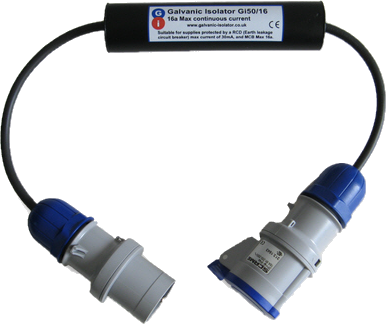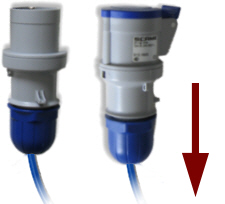Galvanic Isolator Gi50/16 & Gi50/32
Galvanic Isolator Instructions Download
 The galvanic isolator protects the hull of your boat from corrosion caused by galvanic and leakage currents that arise due to chemical interactions between your boat and nearby boats/structures and bankside.
The galvanic isolator protects the hull of your boat from corrosion caused by galvanic and leakage currents that arise due to chemical interactions between your boat and nearby boats/structures and bankside.
It is only necessary to use a galvanic isolator when you are connected to shore (mains) power. It is not necessary when you are using a generator or other power source that is not connected to Earth. It may nevertheless be left connected, as it will have no detrimental effect.
The Galvanic Isolator simply connects to EITHER end of your shore line. It can be connected either at the boat end or the shore end. Both options work equally well.
Locate your galvanic isolator where it will not be subjected to excessive heat, physical damage or water ingress, particularly the plug & socket. (Rain is acceptable – immersed or in running water is not).
When installed, to avoid water ingress, we strongly advise that the cable entries to the plug & socket should point downwards.
 Switch off the electricity supply at the shore supply
Switch off the electricity supply at the shore supply- Unplug the shore line from whichever end you choose
- Connect the isolator to the now free end of the shore line
- Connect the free end of the isolator to the boat/shore supply
- Switch on the electricity supply at the shore supply
- Check that the RCD test button on the boat operates normally
Note: The galvanic isolator is suitable for shore supplies that are protected by an RCD (Earth Leakage Circuit Breaker) with a trip current not exceeding 30mA, and an MCB (Circuit breaker) not exceeding 16A (Gi50/16) or 32A (Gi50/32). If in doubt, please consult a qualified electrician, or call us. We will be glad to help.


